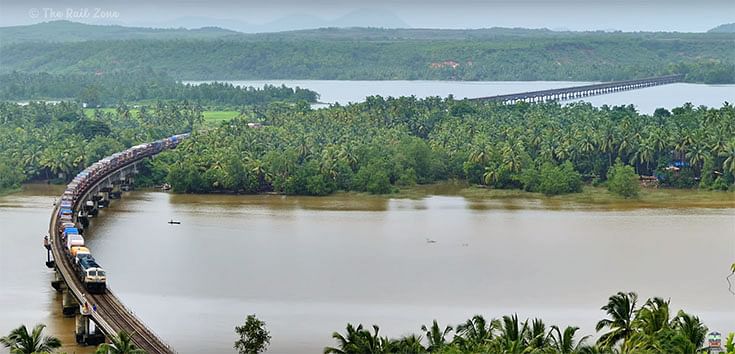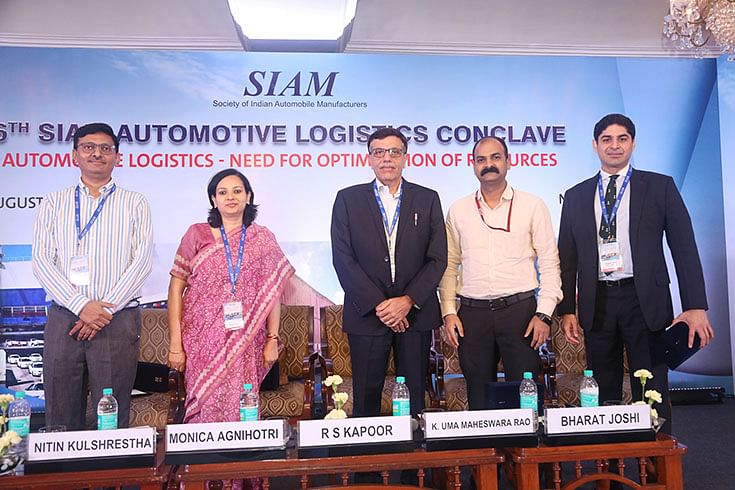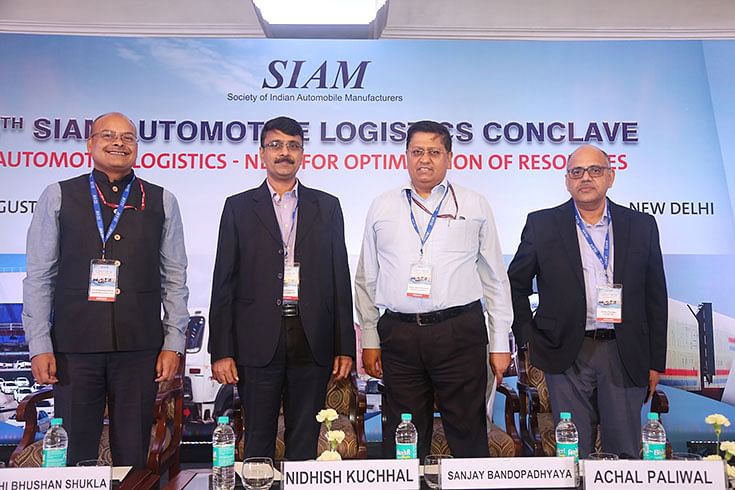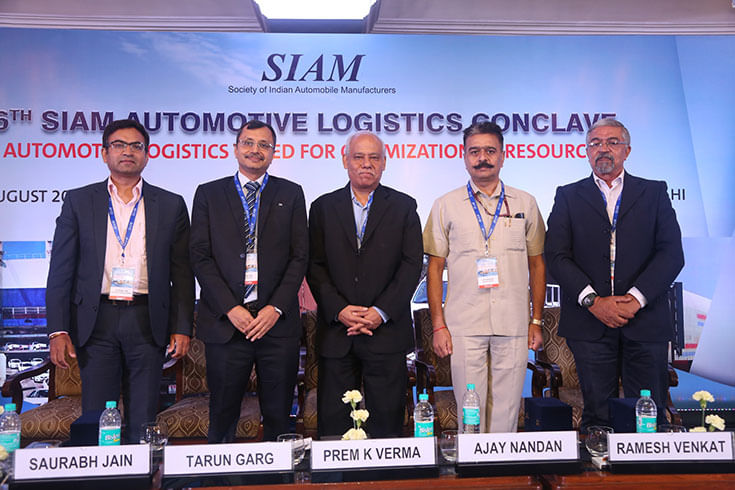SIAM Logistics Conclave sees experts urge resource optimisation, multi-modal transport
The apex industry body saw panelists discuss the need to promote the use of a multi-modal transformation system to drive gains in automotive freight transfer.
On August 1, SIAM inaugurated the sixth edition of the SIAM Automotive Logistics Conclave, its annual two-day event that offers a platform to logistics and supply chain management companies to talk and debate industry topics of critical importance.
The conclave, on the overall theme of ‘Need for optimization of resources’ has drawn logistics heads, suppliers and OEM heads to find solutions to optimise resources and mitigate gaps to facilitate industry growth.
Setting the tone for the conclave on its inaugural day, Prem K Verma, chairman, SIAM Logistics Group and project leader - Distribution & Logistics Strategy, Tata Motors, said, “Our vision is to facilitate need-based interactions for developing a better understanding of automotive logistics and their requirements. As the automotive industry wants to contribute to over 12 percent to India’s GDP as part of its vision under the Automotive Mission Plan (2016-26), it needs to optimise its resources.”
Citing comparative scenarios between India and other key automotive countries, Verma said, "The cost of logistics in India is high, especially in automotive logistics where 96 percent of transportation is done by road, compared to the US where a sizeable 70 percent transportation is done by railways, with the same standing at well over 35 percent in case of Europe. We need to move towards railways and inland waterways to improve logistics costs."
Multi-model transport can drive gains for auto
Delivering the keynote address, N Sivasailam, special secretary, Department of Logistics, Ministry of Commerce, Government of India, said, “It is time we start prioritising freight, for which I have also requested a policy shift. We need a system to track cargo shipments, by having improved timetables to monitor the incoming and outgoing of the ships. We also need to work closely with the Railway Ministry to make the operations profitable for licences. The inland port at Pandu has railway and road connectivity as well as a port facility which can provide immense opportunities for auto industry’s development and employment. The Brahmaputra, which is more than 900km long, offers huge scope for providing logistic solutions for movement of goods across domestic and international channels."
He further took up the cause of drivers and added that, “We should also focus on improving the condition of the drivers in the country, so that they can perform efficiently. It is inhumane to make drivers drive in stuffy hot conditions of high temperatures in India. Fleet operators should be sensitive towards drivers. While ensuring livelihood to drivers, they should also give them human driving conditions in the form of air-conditioned cabins."
"One shouldn't be making profits at the discomfort of the driver. I appeal to all CV OEMs to only bring AC cabins right from the factory to encourage acceptability by fleet operators," he said.
The inaugural session was concluded by B C Dutta, vice president, Hyundai India, who urged all the stakeholders to join hands, work together and find solutions to bring the economy back on track, and help tackle the current recession in the automobile industry.
Optimising outbound logistics
The second session of the day was about optimising outbound logistics and was chaired by Prem K Verma. Making the first remarks, Umesh Bhanot, MD, APL Logistics Vascor Automotive, said in his presentation, "When we talk about optimisation of outbound logistics, it is important to recognise its various dimensions like finished vehicle logistics and after-market parts. Parameters of optimisation, as defined by OEMs, are quality of processes, cost, delivery and environmental impact. To achieve optimisation in transport mode, options available are roads (suited for short routes), rail (suited for long hauls), coastal shipping (for coast to coast movement) and finally, export (a function of ocean freights). OEMs are also experimenting with various distribution models for optimisation of stockyards. Intermodal rail is a viable transport mode to manage a service-sensitive, lean inventory of auto-parts supply chain."
Highlighting the importance of collaboration of all stakeholders, Jasjit Sethi, CEO, TCI Supply Chain Solutions, asserted, “For optimising outbound logistics, we should consider LoT size (sell few, buy few), order replenishment, mint condition, cost of logistics, network design, medium to long term plans, and carrier optimisation. The only way to win is by working together and respecting the ecosystem.”
The first day of the conclave concluded with a Q&A session and an enlightening panel discussion.
How Indian Railways can lend a helping wheel to India Auto Inc

Since 1998, the Konkan Railway Corporation has been offering Ro-Ro (roll-on/roll-off) services, where loaded trucks are directly carried by railway wagons to their destination. (Photo: The Rail Zone)
On day two of the SIAM Logistics Conclave, the inaugural session,‘Railways - Opportunities Ahead’ was chaired by R S Kapoor, vice-president, Maruti Suzuki India, who said, "Rail volumes have increased. We have set an ambitious target of allocating 30 percent of our produce by trains in the next five years. Despite several initiatives being taken up to improve rail growth, many factors are hampering the growth of the same, such as low turn-around time and lack of adequate infrastructure in maintaining AFTOs."
A good example is Konkan Railway Corporation's RoRo (roll-on/roll-off) services, where loaded trucks are directly carried by railway wagons to their destination. NH-17 passes through the same route which has difficult terrain, and truck drivers often find it difficult due to the combination of ghats, undulating surfaces, narrow roads and poor weather conditions. The ro-ro concept has, over the years, proven beneficial for both truck operators and Konkan Railway Corporation.
The benefits are many. Ro-Ro services save precious fuel, the speed of the Ro-Ro train is fast enough as compared to movement by road, terminal time of loading/unloading is just 15 to 20 minutes in Ro-Ro, better turnaround of trucks, no risk of accidents, no wear and tear of vehicles, less pollution and traffic congestion as the vehicles are not plying on the roads and no toll either.
Monica Agnihotri, executive director (Freight Marketing), Railway Board, said, “Despite the slowdown in the automobile sector (production and sales), there is an increase of 22 percent in loading and 26 percent in railway’s earnings from this sector during April to June 2019 as compared to the same period last year.” Throwing light on the way ahead, she announced, "There is a plan to convert more NMG rakes on priority, a newer, efficient and more versatile design of auto-carriers is in the pipeline. There will be a reduction in the first-mile cost by the construction of railway siding inside the manufacturing unit and procurement of 39 rakes by various operators under AFTO scheme is on a fast-track mode."
Speaking on the progress in freight corridor, especially for dedicated freights, K Uma Maheshwar Rao, IRS, joint general manager, Dedicated Freight Corridor Corporation of India. said, “Presently, Indian railways and roads constitute a heavily loaded network for transportation of freight. To reduce this burden, Eastern Dedicated Freight Corridor, which will run from Ludhiana, Punjab to Dankuni, West Bengal, and Western Dedicated Freight Corridor, which will connect Ludhiana to Mumbai, is under construction." He further stated, "The dedicated freight corridor will transport goods at an average speed of 75kph. Thus, helping to reduce the turn-around time, so much so that a rake loaded in Mumbai in the morning will reach Dadri the same day or the next morning. This is a silent revolution in logistics which is happening in our country. After about ten years, there will be a lot of seamless integration of Indian railways, dedicated freight corridors- Delhi Mumbai Industrial Corridor (DMICDC) & Amritsar Delhi Kolkata Industrial Corridor (ADKIC), and other freight terminals.”
Talking about the coastlines of India and how waterways can be made more productive, Sanjay Bandopadhyaya, additional secretary, Minister of Shipping, Government of India, said, "As per a study conducted by Asian Development Bank (ADB) for the ministry, there is a major movement of cars from the production units in North to South and vice-versa. 40 percent of the car movement takes place between North to South and vice versa. We are wasting a lot of money on logistics which could have been utilised to buy assets for logistics."
Shashi Bhushan Shukla, member (Traffic), Inland Waterways Authority of India, said, “We are presently working on NW-1 on Ganga and the Varanasi terminal was inaugurated by the prime minister recently. NW-2 on the Brahmaputra is also operational, offering connectivity to the Pandu and Mogla for North East and exports to Bangladesh. Indo-Bangladesh Protocol (IBP) route connects NW-1 with NW-2 and NW-16, thus providing alternate connectivity between North-East and Bangladesh."
He further stated that the vessel designs made by the designers from Germany are on the IWAI website, and requested the auto-industry and 3PL operations to take advantage of the developments.
Offering an insight into innovating to improve efficiency, D K Rai, director, Chep India, explained, “We need to deploy small but innovative practices to bring in optimisation. Adhering to standardisation, identifying opportunities to collaborate and prioritising sustainability are the steps to go about it. The starting point can be making the inbound supply chain more efficient by introducing the systematisation of packaging."
The panel also deliberated on logistics and supply-chain management at connected platforms as a way to bring in efficiency. The speakers discussed about providing solutions on tracking the goods in a supply chain on a real-time basis using tools like IoT, GPS and advanced software. The discourse concluded by presenting a roadmap to autonomous supply-chain by focussing on visibility, predictive analytics, prescriptive and finally, self-learning technology.
The concluding session talked about the opportunities, challenges and future of automotive logistics. Despite immense challenges and slowdown faced by the sector, the automotive sector in India still stands at a strong position worldwide. The session touched upon the future of electric vehicles, need for sustainability, mission to plant a million trees (the carbon tons saved in shifting to rail mode from road is equivalent to having planted a million trees) and skilling of drivers. According to reports, by 2025, electric two-wheelers are expected to account for 34.5 percent of all two-wheeler sales in India while electric buses will make up 25 percent of all buses sold.
Being extremely optimistic about the future of automotive logistics, Tarun Garg, Executive Director, Maruti Suzuki India, said, "Developments have to be in line with the environmental needs. There needs to be a driver training school that imparts proper training and licenses to the drivers. With the majority of start-ups coming up in the logistics sector, we need to come together and support them. This is not an additional cost but future investment."
The two-day conclave ended with panel discussions that highlighted immense opportunities for the logistics industry by deploying a multi-modal approach in roads, railways and waterways.
RELATED ARTICLES
VinFast’s second plant in Vietnam goes on stream ahead of India factory
Vietnamese EV maker’s second plant in its home market, which has a 200,000 EVs-per-annum capacity, will focus on produci...
Continental exits TBR market in India, shifts focus to car and SUV radials
German tyre manufacturer aims to tap the double-digit market growth opportunity for big SUV and luxury car tyres which w...
New ZF SELECT e-drive platform gives EV makers a choice in 100 to 300 kW range
Modular e-drive platform optimally matches 800-volt overall system and components such as the electric motor and power e...





 02 Aug 2019
02 Aug 2019
 18826 Views
18826 Views

















 Autocar Professional Bureau
Autocar Professional Bureau




